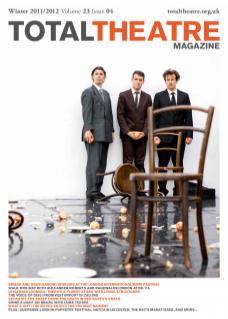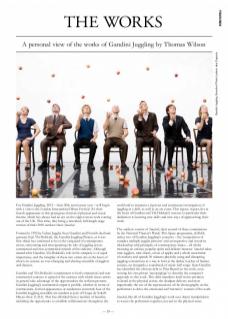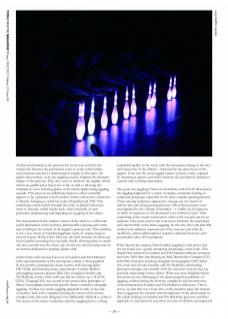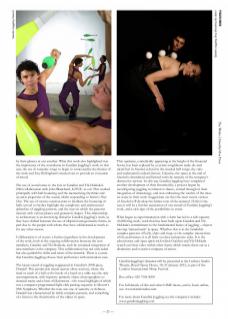For Gandini Juggling, 2012 – their 20th anniversary year – will begin with a visit to the London International Mime Festival. It’s their fourth appearance at this prestigious festival of physical and visual theatre, which has always had an eye on the edgier circus work coming out of the UK. This time, they bring a reworked, full-length stage version of their 2010 outdoor show Smashed.
Formed in 1992 by Cuban Juggler Sean Gandini and Finnish rhythmic gymnast Kati Ylä-Hokkala, the Gandini Juggling Project, as it was first titled, has continued to be in the vanguard of contemporary circus, reinventing and reinvigorating the role of juggling across commercial and non-commercial strands of the industry. Although named after Gandini, Ylä-Hokkala’s role in the company is of equal importance, and the interplay of these two artists sits at the heart of what is in essence an ever-changing and altering ensemble of jugglers and dancers.
Gandini and Ylä-Hokkala’s commitment to both commercial and non-commercial contexts is typical of the easiness with which circus artists in general take advantage of the opportunities the artform presents. Gandini Juggling’s commercial output is prolific, whether in terms of commissions, festival appearances or residencies (currently four of the Gandini Juggling ensemble are resident as part of Cirque de Soleil’s Macau show ZAIA). This has afforded them a number of benefits, including the opportunity to establish collaborations throughout the world and to maintain a rigorous and continuous investigation of juggling as a skill, as well as an art event. This rigour, in part, lies at the heart of Gandini and Ylä-Hokkala’s success, in particular their dedication to learning new skills and new ways of approaching their work.
The outdoor version of Smashed, their second of three commissions by the National Theatre’s Watch This Space programme, skilfully unites two of Gandini Juggling’s concerns – the ‘composition of complex multiple-juggler patterns’ and an inquisitive and inventive relationship with principles of contemporary dance – all whilst retaining an unfussy populist spirit and delicate humour. Smashed takes nine jugglers, nine chairs, a host of apples and a whole assortment of crockery and spends 30 minutes playfully using and disrupting juggling conventions as a way to hint at the darker reaches of human contact, set alongside a soundtrack of music hall songs. Sean Gandini has identified the obvious debt to Pina Bausch in the work, even coining his own phrase ‘tanzjonglage’ to describe the company’s approach to this work. This debt manifests itself in the attention to detail in the physical action, the deadpan delivery and most importantly the use of the repercussions of the choreography on the performers to drive the emotional and ‘narrative’ content of the work.
Smashed, like all of Gandini Juggling’s work uses object manipulation to weave the performers together, not just in the physical sense of their involvement in the patterns but in the way in which the connection between the performers come to evoke relationships and situations that have a dramaturgical weight. In this piece the apples and crockery, as in any juggling routine, heighten the dramatic impact of the patterns. They also serve to reinforce the slightly-stilted afternoon garden party feel to the work, as well as allowing the company to cast a knowing glance at the classic apple-eating juggling cascade. This sense of an underlying tension to what ostensibly appears to be a pleasant social occasion further echoes the connection to Bausch, bringing to mind her works Kontakthof and 1980. This underlying tension builds through the work, as playful behaviour turns to sarcasm, verbal insults and a final crescendo of each performer undermining and impeding the juggling of the others. The denouement of the outdoor version of the show is a wilful and joyful destruction of the crockery, intentionally rejecting each catch and revelling in the refusal of the juggler’s primary task. This rebellion is not a new choice in Gandini Juggling’s work, its origins lying in their first piece nEither Either botH and, the final moment of which saw Sean Gandini cascading five clay balls, finally allowing them to smash one after another into the floor, one of only two natural end-points to an artform dedicated to keeping objects aloft.
nEither Either botH and was born out of Gandini and Ylä-Hokkala’s early experimentations with contemporary dance. Choreographed by the prolific contemporary dance teacher and choreographer Gill Clarke and featuring dance experimenter Lindsey Butcher and juggling notation pioneer Mike Day alongside Gandini and Ylä-Hokkala, nEither Either botH and, like the follow-up CAUGHT- “STILL”/hanging(CSH), was rooted in the postmodern principles of Merce Cunningham and mixed specific dance vocabulary alongside juggling. In these two works juggling appeared to take on the role of another ‘task’ to be completed during the course of the action; complex tasks that were designed to be deliberately difficult to achieve. The fusion of the dance vocabulary with the juggling led to a lilting suspended quality to the work, with the movement taking on the arcs and trajectories of the objects – informed by the quiet focus of the juggler. Gone was the street-juggler’s patter in these works, replaced by momentary glances and smiles between the performers, leading to a gentle and soothing theatricality.
Also gone was juggling’s front-on orientation, and in both these pieces the juggling happened in a variety of angles, sometimes leading to sculptural groupings, especially in the more complex passing patterns. These moving sculptures appeared to emerge out of a fusion of side-by-side and facing passing patterns. Often these patterns were accompanied by the ‘calling’ of numbers – a visible cue for patterns or shifts in sequences, to be developed even further in Septet. Thus something of the occult construction of the work was laid out for an audience. Like some secret code it served to reinforce the mysterious and otherworldly in the dance-juggling. In this way, the work playfully worked with audience expectations of the virtuoso and with the meditative, almost philosophical, inquiries inherited from the early postmodern ideas of Cunningham.
What Smashed has acquired that Gandini Juggling’s early pieces had not yet found was a gently simmering dramaturgy in the work. This thread first surfaced in Gandini and Ylä-Hokkala’s delicate, sensuous and witty 2003 duet Stop Breaking my Balls. Directed by Company FZ’s John-Paul Zaccarini (working alongside choreographer Gill Clarke) this work started from Gandini and Ylä-Hokkala’s relationship, playing knowingly and carefully with the universal tensions that any personal relationship carries with it. What was most delightful about this work was the embracing of the dramaturgical possibilities of juggling, without losing the dextrous complexity and inventiveness of the patterns that Gandini and Ylä-Hokkala could weave. This is not to say that this was a foray into a fully narrative piece but instead that it suggested the dynamic and development of the relationship via the subtle crafting of Gandini and Ylä-Hokkala’s personas and their approach to each pattern’s execution in terms of rhythm, accompanied by their glances at one another. What this work also highlighted was the importance of the soundscore in Gandini Juggling’s work: in this case the use of romantic songs to begin to contextualise the themes of the work and Guy Bellingham’s musical saw to provide an evocation of mood.
The use of sound came to the fore in Gandini and Ylä-Hokkala’s 2004 collaboration with John Blanchard, K-DNK: no exit. This worked principally with ball-bouncing and the mesmerising rhythmic and acoustic properties of the sound, whilst responding to Sartre’s Huis Clois. The use of various constructions to facilitate the bouncing of balls served to further highlight the complexity and architectural splendour of juggling patterns, and the ways in which the patterns interact with various planes and geometric shapes. This relationship to architecture is an interesting thread in Gandini Juggling’s work, as they have shifted between the use of elliptical and geometric forms, in part due to the people with whom they have collaborated as much as for any other reason.
Collaboration is of course a further ingredient in the development of the work, both in the ongoing collaboration between the core members, Gandini and Ylä-Hokkala, and the continual integration of new members in the company. This collaboration has not only aided but also guided the shifts and turns of the material. There is a sense that Gandini Juggling choose their performers with meticulous care.
The latent sound of juggling reappeared in Gandini’s 2008 piece, Downfall. This production mixed austere silent sections, where the thud or catch of a ball or the brush of a hand on a table was the only accompaniment, with hypnotic painterly object choreographies to classical music and a hint of illusionism – the visual highlight of which was a computer-programmed light-club passing sequence to Mozart’s 25th Symphony. Whether the tone was one of austerity or richness Downfall was characterised by richly complex patterns, and something of a hymn to the theatricality of the object in space.
This opulence, coincidently appearing at the height of the financial boom, has been replaced by a certain rough-hewn make do-and-mend feel in Smashed, echoed in the musical hall songs, the suits and understated cocktail dresses. Likewise, the space at the end of Smashed is disordered and littered with the remains of the company’s destructive actions. In this way Gandini Juggling have completed another development of their theatricality, a process begun by reconfiguring juggling in relation to dance, carried through in their integration of dramaturgy, and now embracing the totality of the mise-en-scene in their work. Suggestions are that the most recent version of Smashed will develop the darker tone of the material. If this is the case it will be a further maturation of one strand of Gandini Juggling’s work, and a rich sign of the possibilities to come.
What began as experimentation with a form has led to a rich tapestry of differing work, work that has been built upon Gandini and Ylä- Hokkala’s commitment to the fundamental basics of juggling – objects moving ‘miraculously’ in space. Whether this is in the fiendishly complex patterns of balls, clubs and rings or the complex interactions of the performers, it is all built on clear and precise rules. It is the adventurous and open spirit with which Gandini and Ylä-Hokkala search out these rules within other forms which marks them out as a distinctive and evocative company of artists.
Gandini Juggling’s Smashed will be presented at the Linbury Studio Theatre, Royal Opera House, 18–21 January 2012, as part of the London International Mime Festival.
For full details of this and other LIMF shows, and to book online, see: www.mimelondon.com
For more about Gandini Juggling see the company’s website: www.gandinijuggling.com



